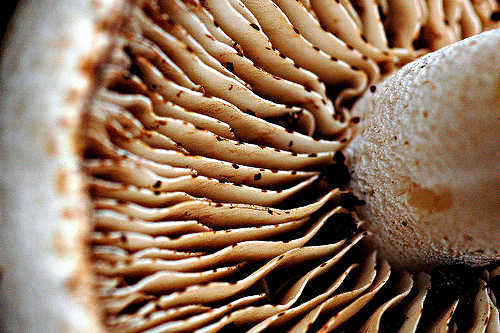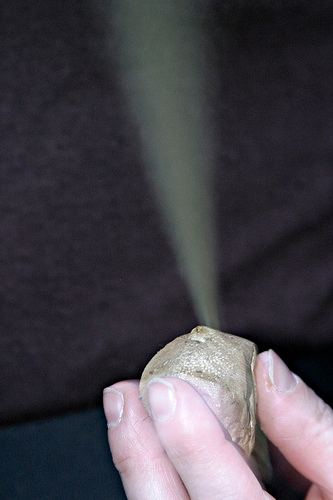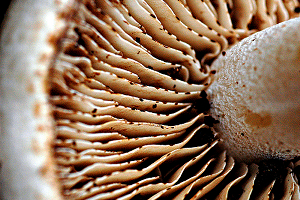Spores can be dispersed as they fall from the gills or, in some species, when the mushroom actively ejects them into the air. Spores that are ejected are called ballistospores. In the case of the puffball mushroom, the spores are released when there is pressure on the outside of the puffball. This can happen as the puffball rolls across the landscape, or when raindrops fall onto the surface of the puffball. Spores can be spread by wind or small animals. If spores fall on suitable substrate, they grow into hyphae, which brings us back to the fungus’s underground life.
The threadlike hyphae of a fungus, together, are called the mycelium. This is the organism’s non-reproductive part. Fungi can grow to be gigantic—although we’d never know it, because they’re mostly underground. The largest known fungus is in eastern Oregon, and it underlies 2,200 acres of forest—an area equal to 1,665 football fields.
The presence of the underground fungus explains why if you find some tasty porcinis in a particular spot, you’re likely to find more if you revisit the same spot on your next hike. It also explains the existence of fairy rings—mushrooms growing along the circumference of a circle. Hyphae grow from the tips outward, and mushrooms grow from the tips of the hyphae. All of those mushrooms in the ring are probably growing from the same fungi.
Most of the time, fungi reproduce asexually. However, sexual reproduction does happen. The hyphae of two different individuals can fuse, grow a stalk, and produce spores.
Fungi are not plants. They do not get their energy from photosynthesis. Instead, they get their food from decaying organic matter (leaves, wood, the fruit you forgot in the bottom of your bag). They are ecologically important decomposers. Fungi can also get their food via parasitic or symbiotic relationships with other organisms.
The best thing about fungi, however, is that their fruiting bodies sure can be delicious. Check out QUEST’s Science on the SPOT: Fungus Fair, filmed at the Fungus Fair, held at the Lawrence Hall of Science in December 2010.
QUEST on KQED Public Media.
37.879329 -122.2463347


